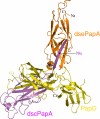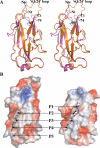Crystal structure of the P pilus rod subunit PapA
- PMID: 17511517
- PMCID: PMC1868955
- DOI: 10.1371/journal.ppat.0030073
Crystal structure of the P pilus rod subunit PapA
Abstract
P pili are important adhesive fibres involved in kidney infection by uropathogenic Escherichia coli strains. P pili are assembled by the conserved chaperone-usher pathway, which involves the PapD chaperone and the PapC usher. During pilus assembly, subunits are incorporated into the growing fiber via the donor-strand exchange (DSE) mechanism, whereby the chaperone's G1 beta-strand that complements the incomplete immunoglobulin-fold of each subunit is displaced by the N-terminal extension (Nte) of an incoming subunit. P pili comprise a helical rod, a tip fibrillum, and an adhesin at the distal end. PapA is the rod subunit and is assembled into a superhelical right-handed structure. Here, we have solved the structure of a ternary complex of PapD bound to PapA through donor-strand complementation, itself bound to another PapA subunit through DSE. This structure provides insight into the structural basis of the DSE reaction involving this important pilus subunit. Using gel filtration chromatography and electron microscopy on a number of PapA Nte mutants, we establish that PapA differs in its mode of assembly compared with other Pap subunits, involving a much larger Nte that encompasses not only the DSE region of the Nte but also the region N-terminal to it.
Conflict of interest statement
Figures






References
-
- Hooton TM, Stamm WE. Diagnosis and treatment of uncomplicated urinary tract infection. Infect Dis Clin N Am. 1997;11:551–574. - PubMed
-
- Dodson KW, Pinkner JS, Rose T, Magnusson G, Hultgren SJ, et al. Structural basis of the interaction of the pyelonephritic E. coli adhesin to its human kidney receptor. Cell. 2001;105:733–743. - PubMed
Publication types
MeSH terms
Substances
Associated data
- Actions
- Actions
- Actions
- Actions
Grants and funding
LinkOut - more resources
Full Text Sources
Research Materials

